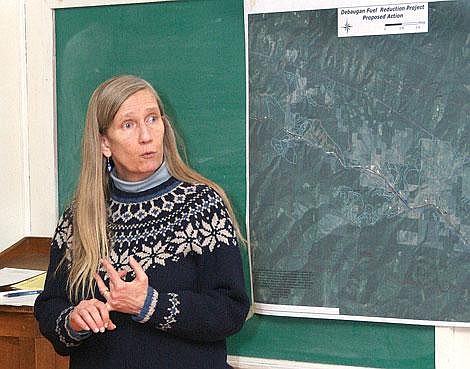Ranger meets with public about DeBaugan project
Residents of the West End of Mineral County got their first chance to publicly voice their opinions on a new Forest Service plan that will reduce the amounts of forest fire fuels in the area.
The DeBaugan Fuels Reduction Project Draft Environmental Impact Statement is a plan to reduce the fire fuels in the Wildland Urban Interface area on the West End of Mineral County, and has been a joint effort between the Forest Service and local residents. Since its release Feb. 8, residents have had time to look over the plan and decide what they like and dislike about the project.
“I know these people are passionately interested,” said Superior District Ranger Sharon Sweeney. “They've been interested for the three years that we've been working on this and I hope they're pleased with what we've done here.”
Around 30 people showed up Thursday night to talk with Sweeney about their feelings on the project. Sweeney said it was their ninth public meeting with the group and she was glad that they finally had some results to discuss.
“I think we have the backing and support of the group as a whole,” Sweeney said
The EIS is in its draft phases and is open to public comment. Sweeney said any public comments that are submitted will be read and taken into consideration as best they can by the interdisciplinary team that will be constructing the final project. Sweeney said the team will consist of herself, a fisheries biologist, a wildlife biologist, a civil culturist, a fuels specialist, and a team leader.
“We're eager to look at all the comments and address them as best we can,” Sweeney said.
All public comments to the Forest Service on the DeBaugan EIS are due by March 24. Sweeney said they hope to have a final project completed by late this summer.
One of the biggest complaints from the residents who attended the meeting was that the project was taking too long. Sweeney said they have been working on the DeBaugan EIS for three years. Many of the residents wanted to see results.
“It was difficult to get to the point where we could actually put some units on the map,” Sweeney said.
Matthew Koehler, of the Wild West Institute, said he felt the main thing that was slowing the project was the funding and staffing issues that the Forest Service is dealing with.
“The Forest Service simply doesn't have the budget or the staff to do the analysis in a timely way,” Koehler said.
The Wild West Institute has been involved with the conception of the DeBaugan EIS for many of the meetings, and has helped get local residents and the fire department together to do spring fuel reduction days. Koehler said that, so far, the Wild West Institute has helped around 20 homes reduce the danger of fire around or near their property. The fuel reduction days focus only on private land, and the fuel reduction that will be done on Forest Service property will be covered in the EIS.
“When you look at protecting communities from fire, it's most important to start at homes and work out from there,” Koehler said.
Another concern of the residents at the meeting was that once the project was finalized they would not be able to contract the reduction work out to logging companies because the lumber market is so poor. Sweeney said this was something the Forest Service was dealing with in many of their projects. She added that they could possibly split the sale up into two different parcels to make it more economic for lumber companies.
“There are many things we can look at to make this feasible and maybe we would even drop some units. It's just hard to say right now,” Sweeney said.
The DeBaugan EIS is a result of community members on the West End of Mineral County coming to the Forest Service with their concerns regarding the fuel reduction in the area. It addresses dangerous fuels in 60,000 acres of land near private property on both sides of Interstate 90.
According to a press release from Sweeney, wildfires have burned around 120,000 acres, or 55 percent, of forest in that area in the past 100 years. However, according to the release, much of the land in the project area has not been affected by wildfire since 1924. Sweeney said that has allowed fuels time to grow and create potential for wildfires near homes.
The EIS calls for commercial harvest, consisting mostly of thinning, on 3,754 acres, pre-commercial thinning on 500 acres, slash and hand piling of fuels on 16 acres of land adjacent to private property, and prescribed burning on 1,142 acres.
A copy of the EIS is available at http://www.fs.fed.us/r1/lolo/projects/ under project and plans. All comments should be about specific problems with the EIS and directed to the Superior Ranger District.

